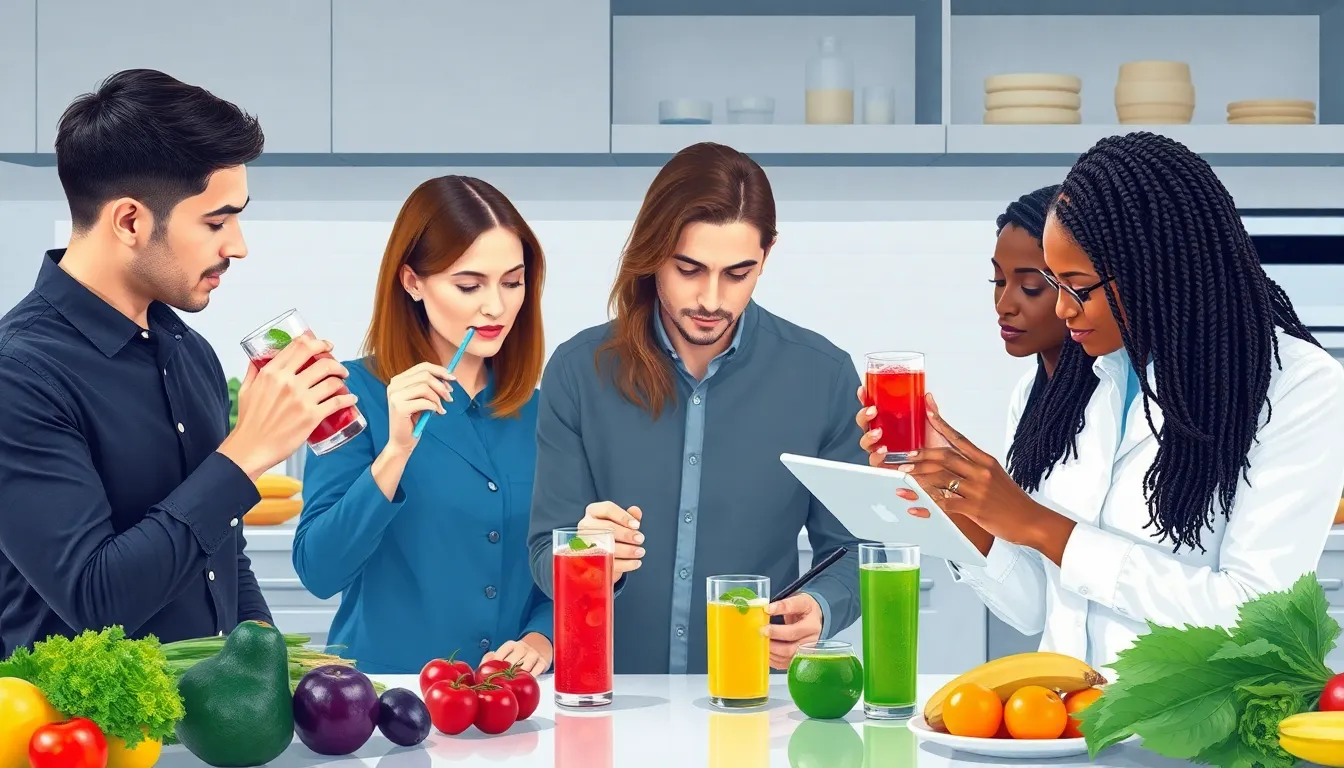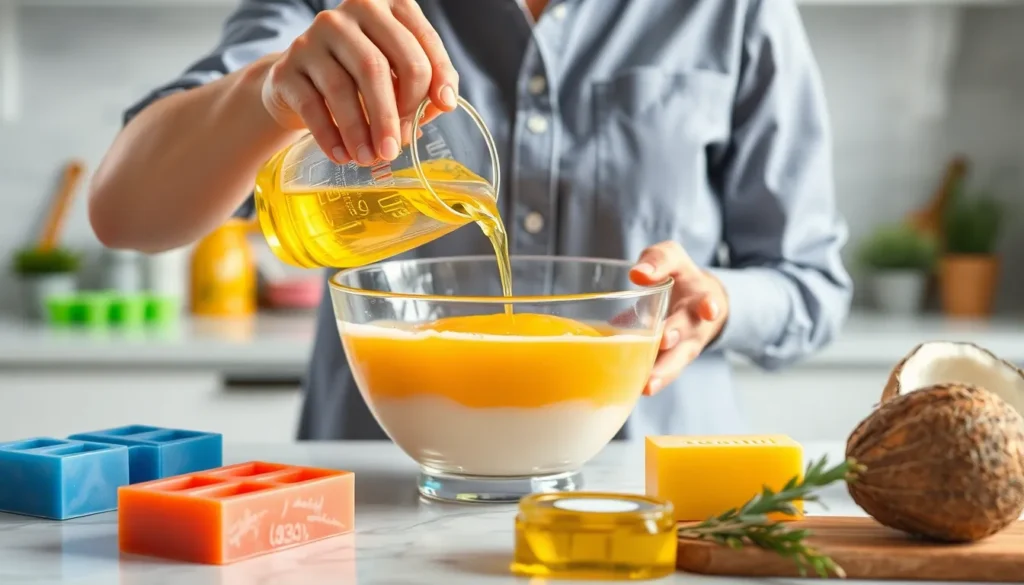In the bustling world of food and beverage, innovation is the secret sauce that keeps consumers coming back for more. From quirky flavor combinations to eco-friendly packaging, product development is where culinary dreams meet market reality. It’s not just about slapping a label on a bottle; it’s about crafting an experience that tantalizes taste buds and sparks joy.
Table of Contents
ToggleOverview of Food and Beverage Product Development
Food and beverage product development involves a systematic process that creates innovative offerings to meet consumer needs. Researchers identify market trends and consumer preferences through thorough analysis. This insight drives the formulation of unique flavors, textures, and packaging options.
The stages of product development include idea generation, concept testing, and market analysis. Idea generation examines various sources such as consumer feedback, competitors, and emerging trends. Concept testing allows for fine-tuning based on initial consumer reactions.
Ingredients selection plays a crucial role in this process. Developers prioritize sourcing quality ingredients that align with consumer health trends and sustainability goals. They often seek natural and organic sources to cater to the rising demand for wholesome products.
Prototyping is another essential step. Developers create small batches of products to test flavors and textures. This approach enables quick adjustments before larger-scale production.
Regulatory compliance cannot be overlooked. Product developers must ensure that offerings meet food safety standards and labeling requirements. They often collaborate with legal teams during this phase to avoid potential pitfalls.
Finally, marketing strategies come into play. Effective marketing communicates the product’s unique selling points clearly to the target audience. Developers craft compelling stories around the products, emphasizing quality and innovation to attract consumer attention.
By focusing on these elements, food and beverage product development aims to create offerings that not only satisfy cravings but also resonate with health-conscious consumers and environmental considerations.
Stages of Product Development


The stages of product development consist of crucial steps that guide the creation of innovative food and beverage offerings. Engaging in each stage effectively determines success in meeting consumer demands.
Idea Generation
Idea generation sparks the development process. Brainstorming sessions foster creativity and encourage collaboration among teams. Inspiration often stems from analyzing consumer preferences and emerging trends in the market. Capturing insights from taste tests and consumer feedback proves beneficial. Diverse approaches such as open innovation and collaboration with culinary experts enhance the variety of ideas. Ultimately, this stage cultivates a rich pool of potential concepts for further exploration.
Market Research
Market research plays a pivotal role in shaping product ideas. Data collection ensures developers grasp trends and segments in consumer behavior. Surveys and focus groups provide valuable insights into preferences and unmet needs. Analysis of competitors reveals gaps in the market and opportunities for differentiation. Identifying target demographics helps tailor products to specific consumer groups. Conducting thorough research equips developers with the knowledge needed to make informed decisions.
Concept Development
Concept development transforms initial ideas into tangible offerings. Storyboarding helps visualize the product’s journey from concept to consumer. Detailed descriptions outline product attributes, including flavor profiles and packaging aesthetics. Prototypes engage potential customers, allowing testing of flavors and textures before full production. Feedback from test groups serves as a guide for refinements and adjustments. Clarity in the concept ensures alignment with market demand and regulatory standards.
Testing and Validation
Testing and validation play essential roles in food and beverage product development, ensuring that products meet consumer expectations and regulatory standards. This stage begins with prototype creation, followed by consumer testing to gather valuable insights.
Prototype Creation
Prototype creation transforms concepts into tangible products. Developers construct small batches to evaluate flavor profiles, textures, and overall appeal. This hands-on approach allows teams to identify strengths and weaknesses early in the process. Variations can be produced, enabling side-by-side comparisons and further refinement. Early prototypes serve as a foundation for adjusting ingredients or formulation methods, optimizing each iteration based on feedback. Engaging culinary experts in this phase can enhance flavor alignment with target market preferences.
Consumer Testing
Consumer testing provides insights directly from the target audience. Focus groups or surveys gather feedback on prototypes’ taste, packaging, and overall appeal. Participants often share preferences related to health, convenience, and sustainable practices. Analysis of this feedback informs necessary adjustments before launching products to market. By prioritizing consumer insights, developers align offerings closer to market demands. Conducting tests with diverse demographic segments ensures a broader understanding of consumer needs, increasing the likelihood of successful product adoption.
Launching the Product
Launching a food or beverage product requires careful planning and execution. This phase translates development efforts into market presence.
Marketing Strategies
Effective marketing strategies capture consumer interest and drive product visibility. Utilizing social media platforms generates buzz through engaging content and influencer partnerships. Packaging design plays a crucial role in attracting attention on store shelves. Incorporating storytelling reveals product origins, enhancing emotional connections with consumers. Implementing targeted advertising campaigns ensures the product reaches specific demographics, aligning messaging with consumer values and preferences. Utilizing promotions, such as limited-time offers or sampling events, creates urgency and encourages trials. Prioritizing customer feedback from initial interactions informs future marketing tactics and improves brand loyalty.
Distribution Channels
Selecting appropriate distribution channels is essential for product accessibility. Employing multiple channels, such as retail, online, and specialty stores, maximizes market reach. Collaborating with established distributors streamlines logistics and leverages existing networks. Direct-to-consumer online sales enhance engagement while providing valuable insights into consumer preferences. Utilizing subscription services increases convenience and secures recurring revenue. Establishing partnerships with food service outlets expands visibility in cafes, restaurants, and catering companies. Prioritizing efficient inventory management and timely deliveries ensures that products maintain freshness and availability on shelves.
Challenges in Product Development
Development in the food and beverage sector encounters several hurdles. Market competition creates a need for innovation, pushing brands to continuously evolve their offerings. Sourcing quality ingredients can present difficulties, especially when prioritizing health trends and sustainability goals; many suppliers may struggle to meet these criteria.
Regulatory compliance also poses a significant challenge. Each product must adhere to stringent safety standards, and navigating these regulations requires thorough knowledge and attention to detail. Market analysis plays a crucial role in the development process, as understanding consumer behavior informs product decisions. Brands often find identifying gaps in the market complex, particularly amid rapidly shifting consumer preferences.
Another hurdle arises during the prototype creation stage. Developers may face challenges when trying to achieve the desired taste and texture. Small batch production helps in evaluating product qualities, but it can be resource-intensive. Gathering consumer feedback through testing requires effective communication strategies, ensuring that test groups provide actionable insights rather than vague responses.
Product launch adds another layer of complexity. Planning for effective marketing must consider a wide range of strategies to garner visibility. Engaging with distributors, retail partners, and online platforms increases market reach but may introduce logistical issues. Moreover, aligning storytelling with brand values requires careful consideration to foster emotional connections with consumers.
Finally, post-launch challenges persist, such as managing consumer expectations and addressing feedback. Brands often face the need to adapt quickly to maintain satisfaction among a diverse audience while ensuring product availability aligns with demand. These challenges require a proactive approach, continuous market research, and a focus on agile practices throughout the product development journey.









